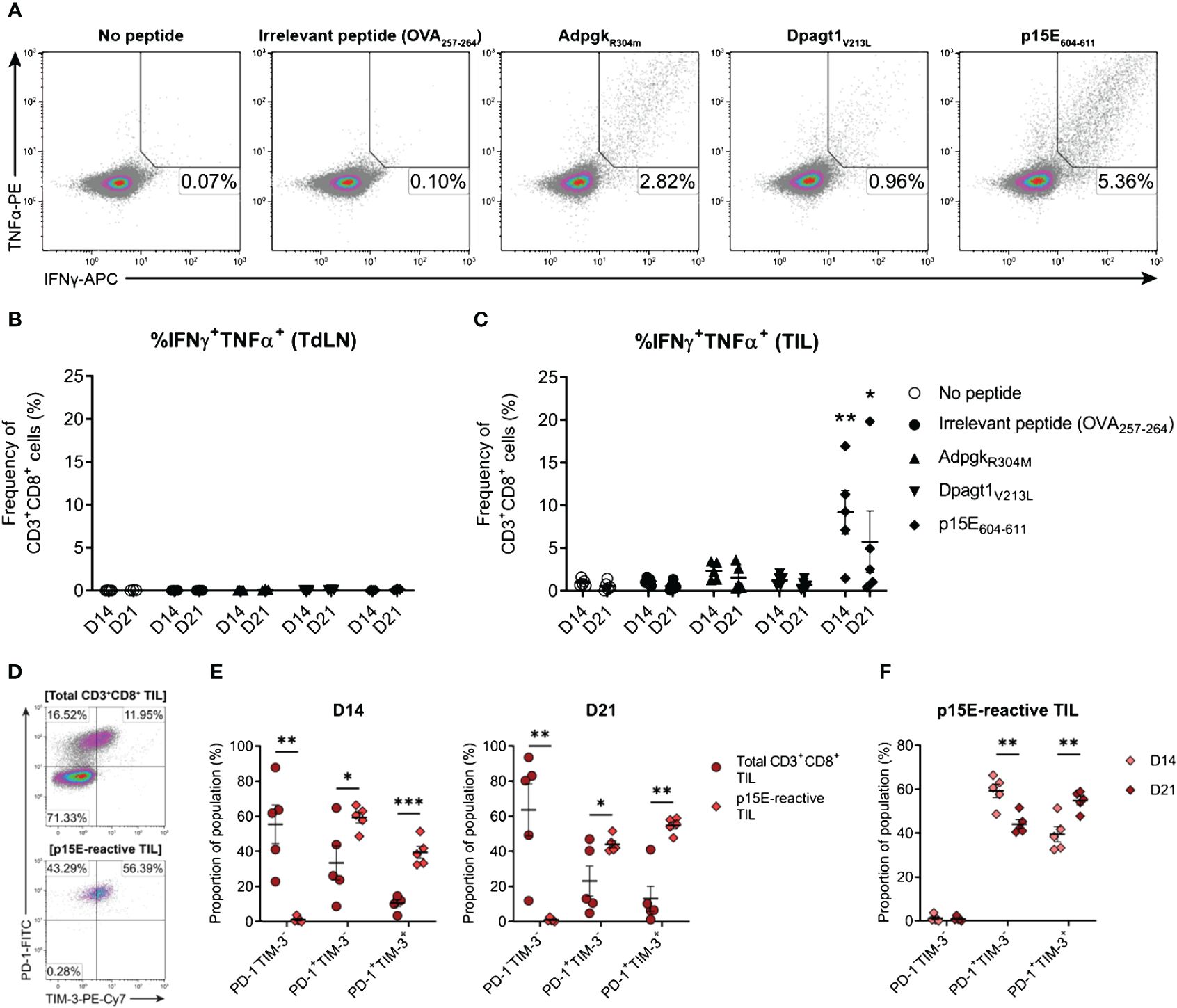- 1School of Medical Sciences, Faculty of Medicine and Health, The University of Sydney, Sydney, NSW, Australia
- 2Department of Pathology, Otago Medical School, University of Otago, Dunedin, New Zealand
- 3Liver Injury and Cancer Program, Centenary Institute, Sydney, NSW, Australia
- 4Charles Perkins Centre, University of Sydney, Sydney, NSW, Australia
- 5Faculty of Science, University of Canterbury, Christchurch, New Zealand
A Corrigendum on:
Late-stage MC38 tumours recapitulate features of human colorectal cancer - implications for appropriate timepoint selection in preclinical studies
By Shields NJ, Peyroux EM, Ferguson AL, Steain M, Neumann S and Young SL (2023) Front. Immunol. 14:1152035. doi: 10.3389/fimmu.2023.1152035
In the published article, there was an error in Figure 10 (panel D) as published. The representative density plot labelled “p15E-reactive TIL” is incorrect and has been mistakenly duplicated from the plot above labelled “Total CD3+CD8+ TIL”. The existing caption for this Figure is correct as published. The corrected Figure 10 appears below:

Figure 10 The endogenous CD8 T cell response to MC38 is dominated by recognition of the p15E tumour antigen. (A) Representative density plots showing TNFα and IFNγ production by CD8+ TILs stimulated ex vivo with BMDCs pulsed with 1 µg/mL of H-2Kb/Db-restricted tumour antigen peptides (p15E604-611, KSPWFTTL; AdpgkR304M, ASMTNMELM; and Dpagt1V213L, SIIVFNLL), unpulsed BMDCs (no peptide) or BMDC pulsed with 1 µg/mL OVA257 -264 peptide (SIINFEKL; irrelevant peptide). Percentages indicate peptide-reactive CD8+ T cell frequencies (%IFNγ+TNFα+) as the proportion of total CD3+CD8+ cells. (B, C) Frequency of polyfunctional CD3+CD8+ cells - isolated from TdLNs (B) and TILs (C) - producing IFNγ and TNFα in response to indicated treatments (%IFNγ+TNFα+). (D) Representative density plots showing PD-1 and TIM-3 expression by total CD3+CD8+ TILs (top) and p15E-reactive CD3+CD8+ TILs (IFNγ+TNFα+, bottom) isolated from D21 MC38 tumours. Percentages indicate subset frequencies as the proportion of the gated populations. (E) Comparison of PD-1 and TIM-3 subset compositions in total CD3+CD8+ TILs (•) and p15E-reactive CD3+CD8+ TILs (♦) from D14 and D21 MC38 tumours. (F) Comparison of PD-1 and TIM-3 subset compositions in p15E-reactive CD3+CD8+ TILs from D14 and D21 MC38 tumours. All data are representative of five biological replicates per timepoint. Graphs represent the mean (line) and standard error of the mean (SEM, error bars). Statistical analyses were performed using two-way ANOVA with post-hoc Dunnett's test, comparing tumour antigen peptide-reactive frequencies to irrelevant peptide controls (B, C), or multiple unpaired Student's t-tests using the Holm-Sidak method to correct for multiple comparisons (E, F). *p ≤ 0.05; **p ≤ 0.01; ***p ≤ 0.001.
The authors apologize for this error and state that this does not change the scientific conclusions of the article in any way. The original article has been updated.
Publisher’s note
All claims expressed in this article are solely those of the authors and do not necessarily represent those of their affiliated organizations, or those of the publisher, the editors and the reviewers. Any product that may be evaluated in this article, or claim that may be made by its manufacturer, is not guaranteed or endorsed by the publisher.
Keywords: colorectal cancer, immunotherapy, syngeneic preclinical models, MC38, immune exclusion, t cell exhaustion, tumour microenvironment
Citation: Shields NJ, Peyroux EM, Ferguson AL, Steain M, Neumann S and Young SL (2024) Corrigendum: Late-stage MC38 tumours recapitulate features of human colorectal cancer – implications for appropriate timepoint selection in preclinical studies. Front. Immunol. 15:1430460. doi: 10.3389/fimmu.2024.1430460
Received: 10 May 2024; Accepted: 31 May 2024;
Published: 11 June 2024.
Edited and Reviewed by:
Peter Brossart, University of Bonn, GermanyCopyright © 2024 Shields, Peyroux, Ferguson, Steain, Neumann and Young. This is an open-access article distributed under the terms of the Creative Commons Attribution License (CC BY). The use, distribution or reproduction in other forums is permitted, provided the original author(s) and the copyright owner(s) are credited and that the original publication in this journal is cited, in accordance with accepted academic practice. No use, distribution or reproduction is permitted which does not comply with these terms.
*Correspondence: Nicholas J. Shields, bmljaG9sYXMuc2hpZWxkc0BzeWRuZXkuZWR1LmF1
 Nicholas J. Shields
Nicholas J. Shields Estelle M. Peyroux
Estelle M. Peyroux Angela L. Ferguson
Angela L. Ferguson Megan Steain
Megan Steain Silke Neumann
Silke Neumann Sarah L. Young1,5
Sarah L. Young1,5